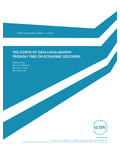Transcription of Platform Evolution: Coevolution of Platform Architecture ...
1 Platform Evolution: Coevolution of Platform Architecture , Governance, and Environmental Dynamics Amrit Tiwana University of Georgia Benn Konsynski Emory University Ashley A. Bush Florida State University Forthcoming in Information Systems Research Abstract The emergence of software-based platforms is shifting competition towards Platform -centric ecosystems, although this phenomenon has not received much attention in information systems research. Our premise is that the Coevolution of the design, governance, and environmental dynamics of such ecosystems influences how they evolve. We present a framework for understanding Platform -based ecosystems and discuss five broad research questions that present significant research opportunities for contributing homegrown theory about their evolutionary dynamics to the IS discipline, and distinctive IT-artifact- centric contributions to the strategy, economics, and software engineering reference disciplines.
2 Keywords: Platforms, ecosystem, Architecture , modularity, environment, evolutionary dynamics, Coevolution , governance 1. INTRODUCTION. Platform -based software ecosystems such as the Firefox browser and its 8,000 add-on extensions or Apple's iphone operating system (iOS) and its 140,000 apps are emerging as a dominant model for software development and software-based services. Unlike traditional software development, they leverage the expertise of a diverse developer community with skills and an appreciation of user needs that platforms owners might not possess to creatively develop new capabilities unforeseeable by the Platform 's original designers. The notion of platforms refers to disparate things in marketing (product lines), software engineering (software families), economics (products and services that bring together groups of users in two- sided networks (Eisenmann, Parker and van Alstyne 2006)), information systems (infrastructural investments (Fichman 2004)), and industrial organization (forming systems (Katz and Shapiro 1994)).
3 Building on the Baldwin and Woodard's (2009) synthesis of the commonalities across these conceptualizations, we define a software-based Platform as the extensible codebase of a software- based system that provides core functionality shared by the modules that interoperate with it, and the interfaces through which they interoperate ( , Apple's iOS and Mozilla's Firefox browser). We define a module as an add-on software subsystem that connects to the Platform to add functionality to it ( , iphone apps and Firefox extensions). We refer to the collection of the Platform and the modules specific to that Platform as that Platform 's ecosystem (Cusumano and Gawer 2002).
4 (Figure 1 illustrates these distinctions, with the corresponding definitions in Table 1.) This combination of the Platform and modules idiosyncratic to that Platform can create formidable competitive barriers for rival platforms. Competing Ecosystem Competi ng Ecosystem Module Module Module Env ironment Interf ac es Platform Ec osy s tem Figure 1: Elements of Platform -centric ecosystems. Software platforms present a significant challenge and opportunity for IS research for six reasons. First, competition is increasingly shifting towards competing Platform -centric ecosystems (Katz and Shapiro 1994), unlike standalone systems that have been the mainstay in the IS systems development literature.
5 This trend is pervasive in browsers ( , Firefox, Chrome, and Opera), smartphone operating systems (iphone, Android), Web services (Google Payments, Amazon Elastic Cloud), social media (Facebook, Apple's Ping), marketplaces (SABRE, eBay), and gaming consoles (Xbox, Apple's ipod Touch, Sony Playstation). Second, the conventional notion of firm boundaries is expanding to harness outside expertise and ingenuity on an unprecedented scale ( , over 100,000 developers for the iphone OS). In contrast, the IT-line function interface within the firm has historically been the locus of IS. innovation in IS research. Prior IS development research cannot readily be applied here because conventional coordination mechanisms are not scalable to this magnitude.
6 Third, technical architectures and organizing principles of these platforms jointly determine their evolutionary trajectories, which in 2. turn influence Platform differentiation. Systems markets such as ecosystems are also inherently dynamic (Katz and Shapiro 1994). However, the IS literature focuses on explaining conventional notions of performance emphasizing predictability rather than explaining how systems evolve over time (Orlikowski and Iacono 2001), and the dynamics of their evolutionary trajectories also remain understudied in management research (Schilling 2000). Even though the importance of Architecture is acknowledged in practice, very little attention has been paid to incorporating it in IS theory development.
7 Although Platform ecosystems function like markets in terms of involving module developers, they are rarely spot transaction oriented and require substantial coordination (Katz and Shapiro 1994). When or how their Architecture facilitates such coordination has received limited research attention. Fourth, governing platforms requires a delicate balance of control by a Platform owner and autonomy among independent developers. Neither the IS controls literature nor the IT governance literature addresses this tension. Fifth, platforms do not exist in vacuum and how well or how poorly they respond to the dynamics of their environment can be influenced by Platform designers' technical choices.
8 Finally, the IT artifact has historically tended to disappear from view, treated as a monolithic blackbox, or become the omitted variable (emphasis in original) (Orlikowski and Iacono 2001). Platforms offer the IS discipline an unusual opportunity to bring the IT artifact into the core of theory development about how platforms evolve and contribute unique insights distinctive from strategy, economics, and software engineering. These issues are particularly germane to IS because understanding how platforms evolve without considering their technical design attributes and relying solely on non-IS perspectives can mislead one into overlooking the important interactions of the IT artifact with its internal and external environment.
9 The overarching objective of this commentary is to identify underexplored questions about how the Coevolution of endogenous design and governance choices by Platform owners and the dynamics of their exogenous environment influences their evolutionary dynamics. Although platforms compete for both users and developers, in this commentary we focus exclusively on the supply (developer) side rather than demand (consumer) side of platforms; software-based platforms (excluding hardware-based ones); and on those that are two- sided markets connecting Platform -specific module developers to end consumers 3. (thereby excluding IT platforms that firms build primarily for their own use, intermediaries, and one- sided markets).
10 The remainder of this commentary proceeds as follows. In 2 we identify five broad research questions on how the Coevolution of the endogenous choices by Platform owners and their exogenous environment influences the evolutionary dynamics of ecosystems and modules over the different temporal horizons described in 3. We discuss four theoretical lenses for constructing causal linkages from Platform Architecture , governance, environmental context to its evolutionary dynamics at both ecosystem and module levels in 4. In 5, we describe the potential theoretical contributions from tackling these research problems. 2. Platform DESIGN, GOVERNANCE, AND THEIR ENVIRONMENT.






